#notes on diatom
Explore tagged Tumblr posts
Text
Writing Notes: Some Causes of Death

There are certain causes of death, or conditions that prevail during the decomposition process, that may cause the body to take on an unusual appearance or to deviate from the expected state of decomposition. These can include:
Drowning
Fire (charring)
Mummification
Carbon monoxide poisoning
DROWNING
Can be accidental, murder, or suicide.
Dumping a body in water may be a murderer’s attempt to dispose of it in the hope that it will remain undiscovered or to degrade any tell-tale DNA or trace evidence.
It is possible for the pathologist to ascertain if death has been caused by drowning or if the person was already dead before entering the water.
The presence of diatoms in the body indicates that death was caused by drowning.
Diatoms - a type of single-celled algae unique to the body of water they are found in; this may be saltwater or freshwater, and from a specific lake or estuary.
They are not present in tap water as it is filtered, and therefore will not be present in somebody who has drowned in a bath, although water present in the stomach and lungs of the deceased is still indicative of death by drowning.
Diatoms can only enter the body by being ingested through the lungs or stomach of a living person while the heart is still beating. Their presence will then be discovered in the blood, bone marrow and brain of the deceased.
When attending water deaths, a water sample will be taken so the diatoms present in the source can be compared to those identified in the body.
In this way, investigators can ascertain whether the victim was drowned in the same body of water in which it was discovered.
Bodies that have been immersed in water for any length of time are likely to be discovered in a macerated form.
This is when the skin wrinkles and loosens to such an extent that it starts to become detached.
The skin may also appear adipocerous: this is when a wax-like coating progressively covers the body when it is overexposed to wet conditions.
Adipocere - caused by the reaction of body fat to water; hydrolysis occurs, resulting in the coagulation of fat, which spreads across the surface of exposed areas of the body.
Vagal drowning occurs when the vagus nerves become unintentionally over-stimulated, resulting in a cardiac arrest.
The vagus nerves serve the lungs, heart, chest and abdomen.
Cardiac arrest can occur when the body is suddenly exposed to cold water, which causes vagal inhibition, particularly when cold water suddenly enters the larynx or ears, or strikes the abdomen in the event of the person falling into water.
This instantaneous reaction leaves a person incapacitated, and is potentially the cause of many deaths of people who are under the influence of drink or drugs and behave without due care and attention when close to canals and waterways.
Inhibition of the vagal nerve can also occur during asphyxiation.
FIRE
This process can be an opportunity for murderers to dispose of cumbersome corpses before they succumb to the unpleasantness of decomposition.
Pathologists will be able to ascertain if the victim was dead before the fire by examining the lungs and airways to detect the presence of soot.
Even if the body is severely blackened through charring, it can still provide pathologists with much needed clues.
If a body has been assaulted prior to the fire, it is possible for pathologists to detect signs of an assault by examining the skeletal remains.
Another indication that a person has been assaulted prior to the fire is the lack of what is called ‘pugilistic pose’ in the body.
This is taken from a boxing stance where the fighter stands with clenched fists and arms, and legs flexed in a particular defensive position.
During a fire, the intense heat causes the hands, elbows and knees to flex and stiffen, drawing the body into this recognized position.
If, however, the victim was assaulted before the fire, then damage to the joints will prevent the body adopting the pugilist position.
MUMMIFICATION
A body may not decompose depending on certain circumstances.
Example: Bodies kept in extremely cold conditions will not succumb to bacteria or insect activity.
The Lindow Man is one of many preserved bodies recovered from peat bogs across the United Kingdom: his remains were discovered by peat cutters working on Lindow Moss, Cheshire in 1984. Experts have concluded that he died a violent death between 2 BC and 119AD and his body has been preserved for the ensuing centuries due to the cool temperature, low oxygenation and high acidity of the peat bog.
Following death, some bodies may not succumb to the decomposition process because they become mummified.
In order for this state to occur, the body must be exposed to a stable temperature (preferably warm) with a steady air current, which allows the body to dry out.
The desert is an ideal environment to promote mummification, but the right combination of elements nearer to home has also produced the same effect.
Example: In Germany in 1994, police discovered the mummified remains of a lady who they believe had died of natural causes 6 months earlier. She was discovered in her lounge in front of the television, and neighbours only thought to raise the alarm after noticing that her letterbox was overflowing with post. The lady’s body was most likely mummified due to the constant temperature of her room over such a long period of time.
CARBON MONOXIDE POISONING
The introduction of unleaded petrol and catalytic converters in cars has led to a decline in the typical suicide scenario of a desperate person sitting in their car with the engine running and a hosepipe threaded through the window.
Even so, carbon monoxide is still very much a killer due to faulty gas pipes and damaged heaters and fires.
The early symptoms of carbon monoxide poisoning can be similar to flu, but increased exposure to the gas, as well as old age and failing health, can prove fatal to the victim. One of the noticeable, distinct features of a person who has died as a result of carbon monoxide poisoning is cherry reddening of the skin.
In normal circumstances in the first stage of death, there is a noticeable paling of the skin due to algor mortis, therefore this distinctive reddening is an obvious sign that death has not occurred due to natural causes.
Source ⚜ More: References ⚜ Autopsy ⚜ Pain & Violence ⚜ Drowning Mummification & Cheating Death ⚜ Carbon Monoxide Poisoning
#writing reference#decomposition#writeblr#spilled ink#dark academia#writing notes#fiction#creative writing#novel#light academia#literature#writers on tumblr#léon cogniet#poets on tumblr#writing prompt#poetry#writing prompts#writing tips#crime fiction#vasily perov#writing resources
167 notes
·
View notes
Note
Whay if we found silicon based life and all of it gave us silicosis
I read this as scoliosis and didn't even question it.
Silicon-based life has many problems... while silicon is able to work as a replacement for carbon, in fact there are equivalents of organic molecules based on silicon that are highly toxic to us (silanes), it seems less flexible than carbon, because it oxidizes easily turning into basically rock. Silicon is indeed more abundant than carbon but life prefers carbon, though diatoms and plants have silicon structures, and there are lots of ways it can combine with other elements.
One interesting thing tough is that most of the products of silicon would be solid. For example, in a speculative silicon photosynthesis, the main source of structure for their "carbohydrates" could be, SiO2, that is, literally sand, like so:
(some electron donor) + SiO2 -> SiH2O (?)
Or rather that a straight carbohydrate equivalent, it would probably be some sort of "silicone", a bunch of structures of silicon connected by oxygen, according to Wikipedia: "−O−R2Si−O−SiR2−, where R = organic group".
I don't even want to know what kind of enzyme would have to exist for that to work, if possible at all. But since silicones do exist in real life, it's not out of the question either.
And "animals" that did silicon "respiration" would also expel SiO2, since it binds so easy:
SiH2O (or some sort of complex silicone stuff) + O2 -> SiO2 + H + energy (alledgelly)
so they would shit bricks.
In a more serious note while I'm not a biochemist, I could imagine in some conditions, where you could have silicon-based life slowly building up delicate structures of silicon oxide, like stromatolites. Or perhaps in higher temperatures where things are melting, more complex things might be very possible, though that would also be a very chaotic enviroment enduring structures. Though it seems just the appropiate place to evolve crystal-like structures like in science fiction.
And it's also been plenty demostrated that complex silicon structures are capable of life-like conditions, even rudimentary thought. I'm typing in one right now.
#worldbuilding#astrobiology#spec evo#speculative evolution#spec bio#speculative biology#biology#biotipo worldbuilding
194 notes
·
View notes
Text
Monday's Musings: The Development of Biomineralization

William Buckland first noted the seemingly rapid appearance f fossils in Cambrian strata in the 1840's.

And Charles Darwin discussed the then inexplicable lack of earlier fossils as one of the main difficulties for his theory of descent with slow modification (natural selection) in his 1859 book which you've probably heard of.
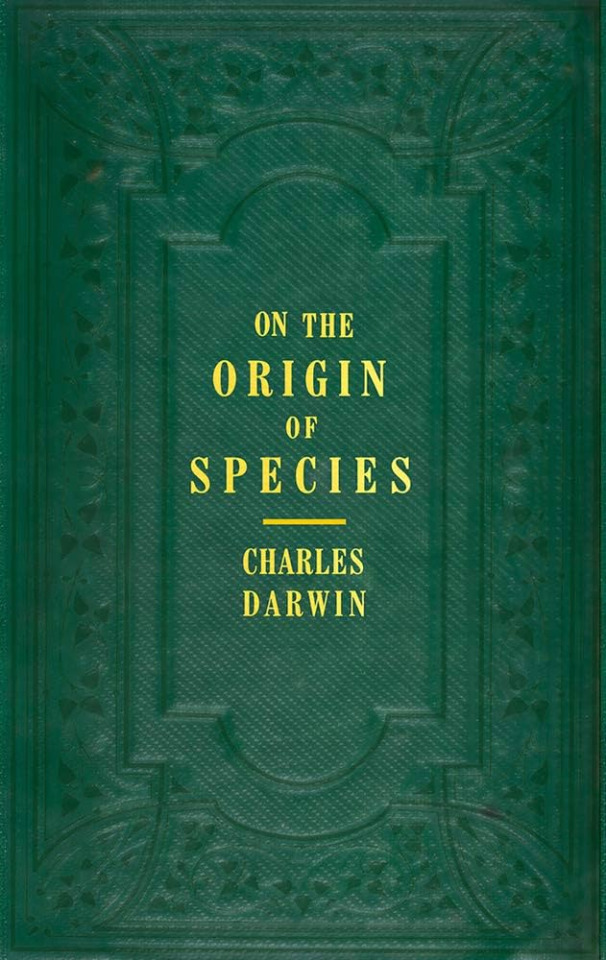
This seemingly sudden appearance of fauna raised three big questions: was there actually a mass diversification of complex organisms over a relatively short time during the early Cambrian? What caused such rapid change? What does it imply about the origin of early animal life?

Edward Lhuyd, the curator of Oxford Museum in 1698, first discovered Cambrian fossils in the forms of trilobites. From that point on, trilobites became some of the most important fossils for dating Paleozoic rocks (these are called index fossils). Buckland recognized that a dramatic step-change in fossils occurred near the base base of the Cambrian thanks to trilobites and Adam Sedgwick and Roderick Murchison used them for dating Cambrian and Silurian strata.

Charles Walcott suggested that there was an interval of time prior to the Cambrian fauna that did not preserve fossils or was simply not in the fossil record (maybe the rocks had eroded away before Cambrian deposition).
Today, we have fossil evidence that the earliest like goes back 3.8 billion years ago. Rocks of that age in Australia contain stromatolites,
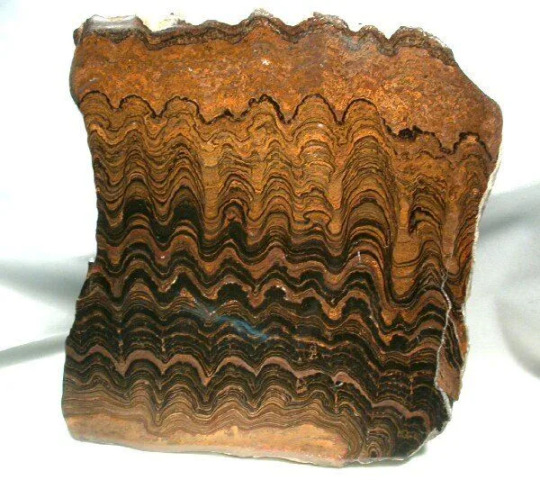
colonies of microorganisms called cyanobacteria.
Fossils of more complex eukaryotic cells called Grypania have been found in China and Montana in rocks dating 2.1 billion years old.
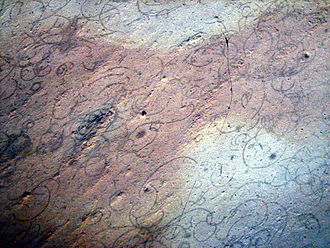
Rocks from about 600-541 Ma have also been found to contain fossils that we now call the Ediacaran Biota but that deserves a post all on it's own.
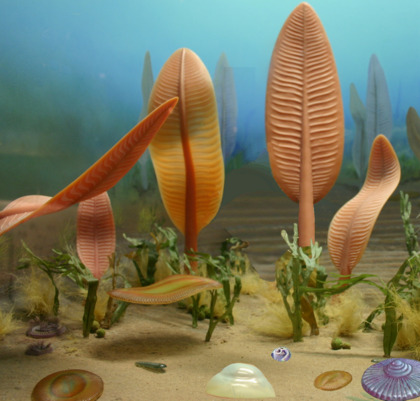
A reevaluation of the Burgess Shale fauna in the 1970's sparked a renewed interest in the explosion.

Harry B. Whittington realized that many of the animals Walcott had found were just as complex as modern animals but they were also very different. He noted that Marella was clearly an arthropod but not a member of any known class.
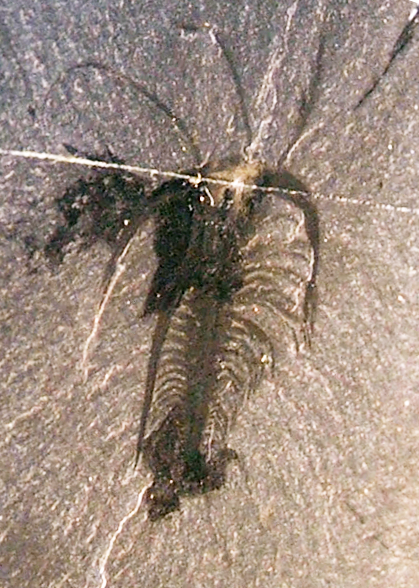
He also noted that animals like Opabinia and Wiwaxia were so different than anything alive that they must belong to their own phyla.
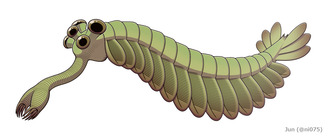
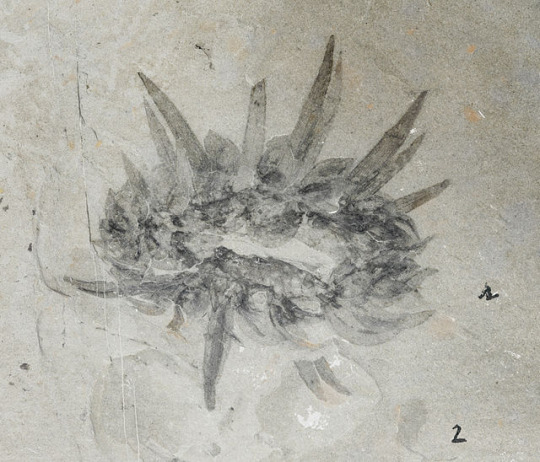
Now, we know that there was complex life at the end of the Proterozoic Eon so the Cambrian is not the "beginning of life" like we used to believe. So, why is the Cambrian explosion still so important?
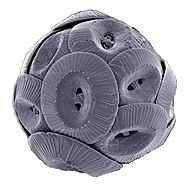
Biomineralization. This is the time period where hard parts began to develop. This is the process by which living organisms produce minerals often resulting in hardened or stiffened mineralized tissues. An example you probably don't think about is your own skeleton. Your skeletal tissues are made up of collagen and calcium phosphate. Other types of biomineralization include silicates in algae and diatoms (these often create chert in limestone) and carbonates (such as chalk) in invertebrates.
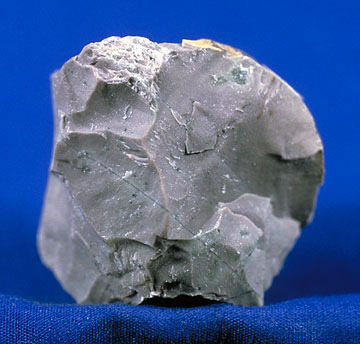
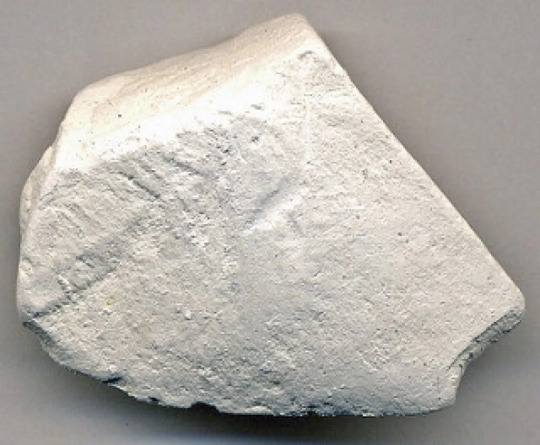
Why did hard parts start showing up in the early Cambrian and not before? One hypothesis is that atmospheric oxygen was finally high enough to allow metabolisms to work efficiently enough to create collagen, a protein made of amino acids that provides structural support in connective tissues.
Another hypothesis is an increase in the concentration of calcium in seawater. Animals that create hard parts from calcium carbonate do so in a very specific way. First, carbon dioxide gas must be dissolved in seawater. It then reacts with the water to create bicarbonate and hydrogen ions. That bicarbonate then reacts again with the water and creates carbonate and hydrogen ions.

Calcium is also an ion just floating about in the water column. Animals then absorb these ions.
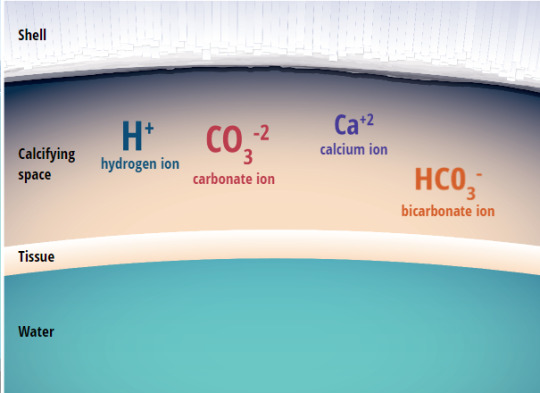
The calcium ions bond with the carbonate ions to form calcium carbonate crystals inside the shell.
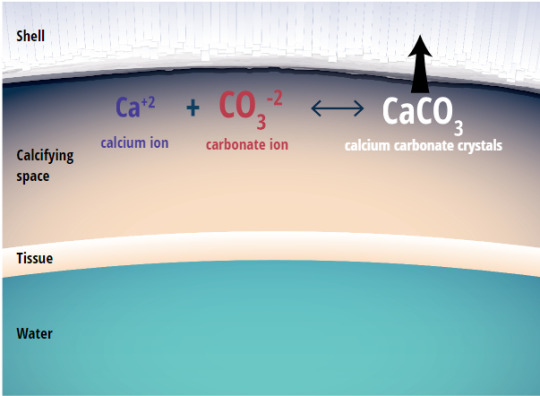
This increase in calcium could also have caused a high rate of erosion (a thought for another Monday).
A final hypothesis is that of predator-prey competition. There is evidence of predation in the Ediacaran fauna such as holes drilled into animals called Cloudina. While the appearance of predation wouldn't trigger hard part development, an increase in predators probably would. In the Burgess Shale alone there are dozens of carnivorous worms, anomalocarids and other arthropods, carnivorous molluscs, lobopods and early jellyfishes that would predate opportunistically.
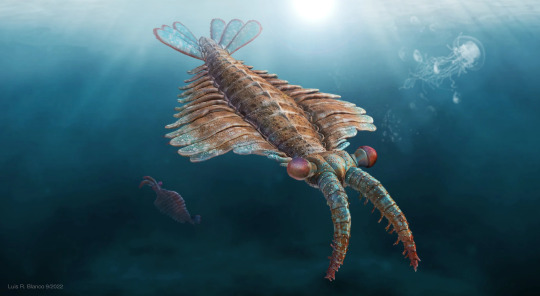
Likely, it was a combination of all these things that led to the rapid development of hard parts. And hard parts stuck around too! Thank goodness or my job would be even harder than it already is.
Fossilize you later!
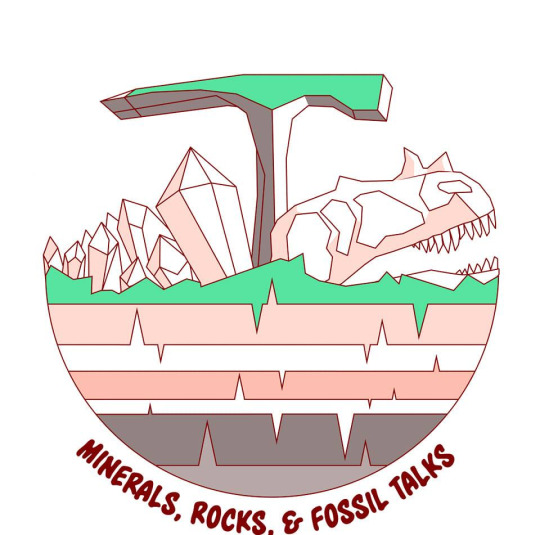
#paleontology#fossils#fun facts#geology#mineralogy#minerals#history#trilobites#anomalocaris#hard parts#cambrian explosion#cambrian period#ediacaran#life finds a way
63 notes
·
View notes
Text

Plankton, a composite image by Roman Vishniac published in LIFE magazine in November 30, 1953.
Caption (note that this was split equally across two pages, and if anyone has a better ID for the critters let me know):
Plankton, the basic food store of the sea, encompasses an immense variety of small floating plants and animals. The more important specimens are shown here without regard to true scale. Most are microscopic, although the largest, the bell-like medusa at bottom of left-hand page, is two inches long. They include: a diatom (straight yellow rod near center of right-hand page); radiolarians and foraminifera (small circular shells to left of diatom); a dinoflagellate (pick-shaped object in lower center of left-hand page); a copepod (above the dinoflagellate); a shrimplike mysid (to right of copepod); a “flying” snail (top, center of left-hand page); sea worms, one with two egg sacs (near upper left-hand corner) and one with tentacles (upper right-hand corner); sea “spiders” (left-hand page, center right and upper right corner); young fishes (right-hand page, left center and top center); larvae of sea urchin (V-shaped object below fish) and of spiny lobster (next to tentacle worm at upper right).
#marine biology#plankton#sea creatures#animals#life magazine#the world we live in#photography#roman vishniac
71 notes
·
View notes
Text
I was part of an undergrad research project developing a protocol to turn algae biowaste (algae scraped off of algal turf scrubbers, a tool used to remediate eutrophication aka fertilizer pollution from bodies of water) into a moldable ceramic product as a sustainable clay alternative or supplement. I'm a biologist, my research professor was a biologist, and we collaborated with a ceramics professor and one of her undergrads.
Dudes, I am not joking when I say that the science the ceramics undergrad did was VASTLY more intensive and rigorous than what I, the "real" scientist was doing. I was essentially playing with sludge, figuring out which processing method (diluting and blending it, then pouring into a plaster mold, or dehydrating, powderizing, and reconstituting) was most efficient and made the best product for my purposes (I wanted to make substrate for oyster larval settlement for oyster bed restoration). The ceramics undergrad was taking the products I made (the powder or the play-doh-like reconstituted sludge) and testing what firing and glazing methods worked well with it. She also mixed it with locally sourced clay (that she located and harvested herself) as a way to bulk up the volume but still keep the properties of the natural clay. She was manipulating the ratio of algae to clay, using different amounts of algae powder as a glaze on natural clay, testing different firing methods/temperatures and had replicates of everything she was doing. She took meticulous notes. She formed HYPOTHESES and PREDICTIONS based on the chemistry of the algae (something about the silica in diatom shells and high salt content, I think) and evaluated them with her results. I was in awe of her. Art IS science and art and other sciences need each other. We don't make progress as a civilization by keeping all of our innovations isolated. When we cross those boundaries and make new connections is when we discover greatness.
Here are some of the sculptures made by our faculty mentors and the ceramics undergrad! Sadly we ran out of algae biomass before I was able to attempt sculpting something myself.


You can read our publication (where the figures came from) for free if you're interested! There's also an article about the ATS system where we got the algae from and what those scientists hope to do with it (make biofuel!)
“the arts and sciences are completely separate fields that should be pitted against each other” the overlap of the arts and sciences make up our entire perceivable reality they r fucking on the couch
#steam education#science and art#make STEM into STEAM#biology#science#conservation#sustainability#sculpture#ceramics#artists#scientists#algal turf scrubber#eutrophication#interdisciplinary research#research
152K notes
·
View notes
Text
Price: [price_with_discount] (as of [price_update_date] - Details) [ad_1] ❤[PRODUCT FEATURES]◆ EASY TO CLEANThis bathroom anti slip mat is oil-resistant and absorbs water quickly. It only needs to be cleaned with a brush or sponge, which saves time and energy. ◆ EFFECTIVELY PREVENT DUSTMultiple colors and patterns washing machine/refrigerator guard will protect your washing machine from dust and any mold. ◆ INSTANT WATER ABSORPTIONStrong water absorption, fast water penetration without accumulation. It can absorb water stains and oil stains quickly. Keep the furniture and floor clean and dry to keep your home comfortable and clean. ◆ USAGE SCENARIOSApart from using it in the bathroom, it can also be used in your bedrooms, kid's room, laundry rooms, restaurant, hotel, banquet, wedding party as a doormat. Perfect bathroom gift for friends and family! It is one of the must-haves at home. ❤[PRODUCT INFORMATION]- Item type: Diatom mud floor mat- Material: Polyester microfiber + Natural rubber- Scope of application: bathroom, kitchen, bedroom, living room, bathtub, etc.-Size-60*60 cm ❤[PACKAGE INCLUDING]1 x Super absorbent non slip mat ❤[TIPS]Do not bleachDo not dry cleanDo not iron ❤[NOTE]1.Due to different lighting and screen settings, the color of the product may be slightly different from the actual product.2.As manual measurement is different, please allow slight size differences.3.If you have any problems about our products, please feel free to contract us firstly, we will reply within 24 hours and provide a satisfactory solution for you. ❤[STUNNING WATER ABSORBENCY EFFECTS] Diatomite bath mat stone are made of diatoms as raw materials that features super adsorption and quick drying ability. Keep your Furniture or floor dry and clean, you can see the watermarks vanish within 1 minutes. ❤[BATH MAT ANTI MOULD] Numerous tiny pores within the bathroom floor mat allows water evaporates quickly in the natural air, quick dry and Anti-Mould. Our bath mat is the hygienic alternative to your old nasty and moldy microfiber bath mat and chenille bathroom rugs. ❤[DIRT-RESISTANT AND EASY TO CLEAN] Bathroom Rug smooth surface better resists dirt and hair, stains and hair do not stay on Bathroom Carpet, just brush the bathroom rugs and rinse it with clean water. ❤[DURABLE AND NO SHEDDING] As the rubber backing is waterproof, so water won’t seep underneath the non slip bath mat and causes bad smell. With the very wear-resistant surface, the bathroom floor mat ensures long-life for use. No worry about the pilling, fading, out of shape, or shedding problems of the traditional shaggy bath mat. ❤[PROTECTION OF ELECTRICAL APPLIANCES] The size of the dust cover is Universal washing machine: 60*60cm.It can protect refrigerators or washing machines from dust and mold, avoid direct sunlight, and extend the service life of household appliances. [ad_2]
0 notes
Text

Phytoplankton Flourish in Patagonian Waters
Bloom season, already underway for several months, continued to dazzle in the productive South Atlantic waters off Argentina. Earlier, in austral spring 2024, satellites captured a clear image of a sizeable phytoplankton bloom along the Patagonian Shelf. Communities of the tiny aquatic organisms persisted into the long days of the Southern Hemisphere summer, painting surface waters in shades of green and blue into late December.
The OCI (Ocean Color Instrument) on NASA’s PACE (Plankton, Aerosol, Cloud, ocean Ecosystem) satellite acquired this image of the bloom and its intricate swirls around the Falkland Islands (Islas Malvinas) on December 28, 2024. In the waters of the Patagonian Shelf-break front, airborne dust from the land, iron-rich currents, and upwelling from the depths provide abundant nutrients for phytoplankton. These floating sunlight harvesters support rich aquatic diversity and productive fisheries.
The various colors visible in the image likely reflect a mix of phytoplankton communities. The proportions of these communities change throughout the months-long bloom based on nutrient availability and other environmental factors. In this scene, chlorophyll-rich diatoms and other phytoplankton types that color the water green may be giving way to coccolithophores, said Ivona Cetinić, an oceanographer at Morgan State University and member of NASA’s Ocean Ecology lab.
“Coccolithophores love long days and lots of sunshine, so they are probably dominating now,” she said. Armored with plates of highly reflective calcium carbonate, these organisms make surface waters appear a milky turquoise-blue. The coccolithophore bloom that emerges each year off Patagonia is part of the so-called Great Calcite Belt. Stretching around the planet in southern waters, the region is thought to play a major role in the planet’s carbon cycle.
The distribution of colors in the image also reveals complexities in the ocean’s surface waters. “Plankton cannot swim against currents,” Cetinić said, “so the different stripes of color indicate many different water masses containing different levels of elements needed for the growth of different phytoplankton types.”
It remains a longstanding challenge to identify what types of phytoplankton are present in a bloom using remote sensing imagery alone. But scientists are getting closer thanks to the hyperspectral (fine wavelength resolution) data acquired by the PACE satellite. Cetinić and colleagues have developed a tool that enabled them to distinguish three different phytoplankton communities based on hyperspectral signatures. The scientists find the method promising but note that it is still under development. Monitoring phytoplankton on a global scale using daily observations by PACE may help scientists and resource managers monitor fisheries health, track harmful algal blooms, and identify changes in the marine environment.
NASA Earth Observatory image by Wanmei Liang, using PACE data from NASA EOSDIS LANCE and GIBS/Worldview. Story by Lindsey Doermann.
1 note
·
View note
Text
Hyperfixating on the ocean rn
I mean I usually am, I'm just even more fixated than normal
🐟🪸🦑
I need to go swimming...
Preferably at the bottom of the ocean
On a related note, diatoms are freaking awesome
And siphonophores omg
N' every single sea slug
And every cephalopod
if you count as a plankton or an invertebrate we can be friends
we can actually just be friends no matter what sea creature you are
This is a wet beast safe space 💙
0 notes
Text
Hunh, this is really interesting
Elner notes the absence of the invertebrates that the sandpipers were reputed to be eating. Yet the birds are constantly pecking at the mud surface. They seem to be voraciously feeding on… nothing? In the mid-1990s, Elner examined the stomachs of a few dead sandpipers. He found only sand particles and liquid. Curious, he shipped a few frozen sandpiper heads to a colleague in Nantes, France, who had a powerful electron microscope to more closely examine the birds’ bills and mouthparts. It turned out that the sandpipers have unusually hairy tongues, and the electron micrographs also revealed microcosmic plants called diatoms on the long, fine bristles of the birds’ tongues. “That was the eureka moment,” Elner says.
When he realized that their tongues were like specialized toothbrushs, he knew they would offer no real advantage in feeding on invertebrates; instead, the sandpipers were using their tongues to scrape biofilm off the surface of the mud. It was biofilm — a thin, sticky layer of microbes, organic matter and sediment bound together by diatom-and bacteria-secreted mucus — that was somehow fuelling the birds on their epic adventures. Until then, the only creatures that were known to eat biofilm were marine invertebrates and fish. Elner and his colleagues figured out that the sandpipers use the biofilm as a special energy drink to power their extreme migration, just like marathon runners. The birds were not loading up on just any mud slime but specifically targeting biofilm containing a high concentration of omega-3 fatty acids, generated by the diatoms.
Those high-nutrient fatty acids — especially two called eicosapentaenoic acid (EPA) and docosahexaenoic acid (DHA) — offer many benefits to the birds, boosting their immunity and reducing inflammation. These essential nutrients also tweak the birds’ flight muscles, transforming them into endurance muscles that can get them to Alaska with enough energy left over to breed. “It enables the birds to be better flyers and to be more efficient on their migration,” explains Patricia Baird, a seabird ecologist who discovered the unique role of diatoms in the production of omega-3 fatty acids.
Experiments with flying western sandpipers in a wind tunnel showed that birds fed food rich in fatty acids increased their flying efficiency by about 12 per cent. “These flights can be likened to a trip to the moon. You need enough fuel and life support to get there,” says Christopher Guglielmo, a biologist who ran the experiments in the wind tunnel at Western University’s Advanced Facility for Avian Research. “If you think of shorebirds as little rocket ships, they have to budget everything out along the whole trip to make it successfully.”


The Magic in the Mud: Sandpipers’ Migration Superfood
An invisible fuel draws thousands of tiny migrating shorebirds to the Roberts Bank Mudflats each year. Now, we’re in danger of losing it forever.
Western sandpipers migrate thousands of kilometres north along the Pacific coast from their overwintering areas as far south as Peru to their breeding grounds in Alaska. These shorebirds, weighing no more than 35 grams, stop at just a handful of places along the North American Pacific Flyway to refuel. Roberts Bank is one of these stopover sites, on the Fraser River estuary in British Columbia. A top biodiversity hotspot in Canada, it’s globally classified as an Important Bird Area...
Read more: https://canadiangeographic.ca/articles/the-magic-in-the-mud-sandpipers-migration-superfood
226 notes
·
View notes
Text
I wonder if Plankton considered hostile takeover ("I'll assimilate...atom by atom!") instead of dismantling. Then we'd see a clip of Tsar Bomba instead.
Never mind that hydrogen fusion actually releases less energy per event than fission. PER EVENT. Not per unit of mass. But since the Spongebob clip shows one atom splitting and creating a nuclear explosion (looks more like a diatomic molecule amirite), might as well go full-misinfo and say that fusion releases more energy per event as well.
Note that the link below is completely uncited and is made by a physics student, probably an undergrad. It was just one of the first Google answers and I liked the phrasing.
0 notes
Text
AI Development Services Review on real AI examples

Current State, Future Prospects, and Comparison of chatGPT, Claude AI and other AI tools The integration of AI systems into our daily lives and business operations is progressing at an unprecedented pace. As developers continuously launch new products and startups across various domains, companies increasingly join this technological marathon to stay competitive and innovative. AI tools for app development Among the innovative offerings in the market, we see systems for automatic source code generation and startups focused on processing legal documents. Many companies, including Diatom Enterprises – a well-known industry leader in AI Development Services, have primarily utilized open platforms like ChatGPT. Recently, there has been growing interest in exploring newer platforms to create apps like Claude AI. AI development solutions beyond text Modern AI systems demonstrate remarkable versatility: Document Analysis: AI can process and interpret complex accounting and legal documents, streamlining financial and legal operations. Image and Diagram Comprehension: Advanced AI models can analyze visual data, including project architecture diagrams, providing insights and facilitating a better understanding of complex visual information. Multi-modal Analysis: By combining text and visual analysis capabilities, AI systems offer comprehensive insights across various data types, enhancing business decision-making processes. AI Assistance: The AI development market sees new systems working as AI assistants. AI Development Services: Claude AI, Danswer AI, and others Claude AI, a contemporary system, offers several advantages in custom software development: Technical Documentation: Assistance in creating comprehensive and accurate technical documentation. Architecture Support: Helping developers conceptualize and design software architecture. Code Generation: Capability to produce both basic and specific code for projects. However, the enterprise adoption of such systems faces challenges: Local Deployment: There's a growing demand for AI systems that can be deployed within a company's local ecosystem, such as Danswer or PrivateGPT. These allow businesses to train Language Learning Models (LLMs) in specific directions relevant to their needs. Limitations of Pre-trained Models: While ChatGPT and Claude are pre-trained models, they can assist in setting up and training localized, manual AI systems for specific tasks like processing unique legal documents, customizing image generation (e.g., logo creation in a company's style), or analyzing invoices for accounting systems. Integration Challenges and API Usage It's important to note that chat interfaces like Claude and ChatGPT are frontend wrappers for powerful AI models accessible via APIs. These APIs form the backbone of AI integration in enterprise solutions: API-based Integration: Both OpenAI (for ChatGPT) and Anthropic (for Claude) offer API access to their AI models. This allows for more flexible and scalable integration into existing systems. Customizable Conversations: When using the API, developers can model the initial conversation manually, effectively "priming" the AI for specific tasks. This approach allows for more targeted and efficient use of AI capabilities. Pricing Models: API usage is typically based on a credit system or token count. Pricing can vary based on the model used and the volume of requests. For example: - OpenAI's GPT-3.5 and GPT-4 APIs have different pricing tiers based on the model's capabilities. - Anthropic's Claude API also uses a credit-based system, with pricing varying by model and usage volume. Performance Considerations: While API integration solves some of the challenges associated with web-based chat interfaces, developers still need to consider the following: Rate limits and concurrent request limitations Latency, especially for real-time applications Managing context effectively to minimize token usage and improve response relevance Data Privacy and Security: When integrating AI via APIs, companies must carefully consider data handling practices, especially when dealing with sensitive information. By leveraging these APIs, businesses can create more robust, scalable, and customized AI solutions that go beyond the limitations of web-based chat interfaces. Metrics and Comparison of AI to build an app Objectively assessing the differences between systems like ChatGPT and Claude is challenging. Comparisons often rely on technical metrics such as price, speed, and quality (which can be subjective). Our software development company has an advantage in that field; we have grown our internal expertise in AI application development since we have many customers and different ways. How much resources do you need to spend to set up a test environment to evaluate the quality of AI for creating an app? How expensive will supporting an AI platform be during development and operation costs? How easy will it be to integrate an AI system to build an app? How the security of the system's machine learning data and results is ensured What is the audience of companies involved in the platform's development and support, and what are the prospects for using this platform in the near future? Future: AI Development Services in Custom App Development (2025) The impact of AI systems on custom software development is expected to be significant. A potential model for future development processes involves using a central AI (like ChatGPT or Claude) to orchestrate other specialized AI engines: System Concept Development: The central AI develops the project's system concept and framework choices. Architectural Design: It generates prompts for AI systems specialized in creating architectural diagrams. Project Templating: The AI creates project templates and instructs tools like GitHub Copilot to build the project skeleton. Creating apps using AI nowadays is extremely popular. This "AI orchestrator" model could allow developers to create projects in the company's style with minimal manual input simply by providing high-level commands or even having the central AI generate these commands based on project requirements. Using ai to build an app is increasingly crucial in our software development world. Conclusion of the AI App Development Services Review As AI technology continues to evolve, its integration into business operations promises to drive efficiency, innovation, and competitive advantage across industries. However, deployment, training, and scalability challenges must be addressed for widespread enterprise adoption. The future of AI app development looks set to be dramatically transformed by AI, with the potential for significant automation and efficiency gains. Read the full article
0 notes
Text


16.05.24 | things done today:
🌼 English
clozemaster
solved a crossword puzzle
advanced vocabulary
🌼 Spanish
clozemaster
watched Nana (cap. 3 | spanish dub w/o subs)
🌼 French:
clozemaster
writing challenge
read an article
watched Le Visiteur du Futur (2x15)
🌼 German
read & translated the Frederick Barbarossa paragraph (textbook literature & history)
babadum
🌼 Botany
algae lectures (above pictures: diatoms algae + kelp forest) + took notes for my commonplace book
🌼 Self care
went for a walk 🌞
📖: Introduction to Psychology by Luciano Mecacci
1 note
·
View note
Text
It’s 13 May 2024, and I want to consider the gs meaning of specific base forms. Beginning with e, and I’ll see if I can even make a start on that. I think it’s the conceptual key because the space that defines is not just a version of 1Space, meaning what I think of now as gs1 to distinguish it from the not necessary to state rs1.
BTW, I need to say that Silly Love Songs, if done with The Beatles, would be considered one of the great songs. That long musical break would bring home the bittersweet depth inherent in a love song. It would be more obviously satirical with great affection. An almost. Not a fan of the drumming.
The gs meaning of e, or the 1Space counting meaning of e, is the count of gs2, and specifically the relation of any count of gs1 to the count of gs2, meaning the complete potential of the count of 2 as 1 Thing. That means the space defined by exponentiating e is that space of a Thing made of 2 Things.
I can’t imagine that idea has ever been written down anywhere before. I almost instantly - I’m eating a bagel with cream cheese and drinking a latte - looked up L’Hopital’s rule to see if it now translates better. It does. The indeterminacy condition, for example, is the connection to 1Space, to gs counting. That enables the other conditions, including the quotient existing. This becomes a terrific example of the relation of gs counting to rs counting. I’m sorry but I have to adopt that idea; it clarifies what’s happening too well. I hate adding jargon to the simple act of counting, but it seems to help here.
I note the condition of differentiability becomes more obvious when you think of a Triangular sheet or a gs sheet. If you can’t compare to find a change, then you’re not representing something visible. Literally in sheets, because we described how and why a diatomic conception emerges. The realization that we can describe the linkage over finite fields of different areas of mathematics has had some far-reaching
I also wish Steely Dan had gone all the way to jazz on some songs. Do It Again. A few notes and inflections would open that up so much.
This greatly simplifies a derivation of Irreducibility. I think. Or hope. Let’s see where this goes. We now have a clearer understanding of 2:1 as a base. That extends all over the place, which is why we find it all over physics: anytime we combine 2:1, then some form of a Thing forms or at least can be evaluated for existence, even if we’re looking for negative existence.
Holy moly. That’s a direct line from one of the work sessions I experienced as a child during development of the Mission Storyline. Way before the Storyline label existed. I remember describing how we examine the patterns for the non-existence where we would expect existence
I love David Gates’ songs. I would give up everything I own. Brings me to tears every time. And of course they follow that with Operator. I loved Jim Croce. I only wish my words could just convince myself it just wasn’t real but that’s not the way I feel. You can keep the dime.
I have been trying to label myself. Visionary mathematician fits because I see math. But also emotional mathematician, because emotions are constructions with too many dimensions to be contained logically, to be seen, so they overwhelm into a
The production on Someone Saved My Life Tonight is perfect. Gus Dudgeon must have been remarkable working with Elton. What a singer.
Let’s shift to another base. What about p-adic numbers? What kind of space do they generate? I think gs counting explains these better than anything I’ve seen because this says we take the rs convert to gs and use as a base exactly as we have described: gs primes incorporate the gs processes which construct the prime and which enable relations to other gs counts, prime or composite.
I wish they’d play Traffic. The low spark of high-heeled boys.
Anyway. Isn’t this the point of p-adic numbers? That they have exactly the properties just described, that the embody process and enable attachment to other processes. They define metric spaces and thus topologies. So yeah. It’s weird to see things like the triangle inequality and how it then extends to the ultrametric, et voilá.
This makes me feel terrible. I mean: we’re barely into the infancy of understanding where this material leads. Like the giant baby at the end of 2001.
Look at 419. The +1 Attachment means we generate a 2:1 Thing, which then I-s checks, meaning Identity-structure checks, across 420, which yes presents as 6*7, which is indeed the full count of a Hexagon, meaning it counts up to the 1Segment on the far side of the Start bT, when counting off both 1Segment edges. BTW, I want to mention here that e begins with 2 because we start with 1 + 1/1. The reason I mention that now is I forgot to note how that embodies the ancient conception of movement as paradox, that steps added together increase forever and that steps divided also increase forever, which is a version of the inversion inherent in a 1-0Segment, meaning in 1Space counting. I say 1Space there because that’s higher level than gs counting, though I’m sometimes using one for the other, for which I apologize. It should be clear that 1Space counting includes gs counting along with Triangular, Hexagonal, and the entire ideal form generation in D-structure.
There is something more in that. Let’s tug on it. See what comes out.
Ideal form generation in D-structure tests through and into or as I-s. Okay. So what that means is each level of representation, each form, generates against ideal, and the extent - which becomes an Extent - of match or difference appears. That can model as simply as a stretch of Ends along an Extent which we can stand on ‘End’ so it acts as a door or some count, like a scalar or other result.
That generates pathways through higher dimensions based on best fit. I communicated with a person with late onset hallucinatory schizophrenia. Said some delusions were contextual, like conversations with her children, but others were not, like a dead person staring at her. I can see how these can be incorporated within a larger gsSpace that resolves this way, and thus which distinguishes the weird from the sensible, and then further at a more local level, the sensible but not actual from actual, as that 1-0Segments. This means they’re taking an End, and flipping it, putting the delusional End on the wrong side of the experiential Boundary. That works in 2:1 more easily than I would have thought, because that draws a line in the perceptual field which populates on the ‘wrong’ side.
And here, the only grand gesture I can offer you is fundamental understandings and how they can be applied to help life both here and through eternity. That’s effectively all I can offer you. In O notation, after all, eternity is overwhelmingly more valuable than anything else. It’s the ultimate asymptote.
0 notes
Text
The West African fiddler crab, Uca or Afruca tangeri, is an intertidal species, and is the only species of fiddler crab in its Eastern Atlantic range. Recently this species has been imported from Nigeria, where it is present in mangrove habitat, among the roots of Avicennia and Rhizophora trees. The maximum carapace length of this sexually dimorphic species is under 4 centimeters, or 1 and a 1/2 inches, although the size of the females is smaller than the males, closer to 3 centimeters, not very much over an inch. Like all fiddler crabs, only the male of the West African species has modified its major claw, so as to be so enormous. Its use is as a visual signal, whilst the the minor claw, and incredible claws of the female, are used in feeding.
As can be seen from their size and shape, the feeding claws of U. tangeri are unsuitable for harming struggling prey. The primary diet of this fidder crab in Nigeria, is detritus, but it is well able to pluck at multicelluar plant materials, and it also consumes unicellular diatoms and other microalgae. Ecologically this species is regarded as an ecosystem engineer, for the effects of its feeding and burrowing behaviours on its environment.
U. tangeri is a true euryhaline species, able to tolerate a wide variety of salinity levels, but typically found at mid tide. Usually it seems to frequent waters with affinities about equal to our low to middle brackish aquariums, but experimentally this crab tolerates higher salinities without obvious stress, and wild populations have even been reported from the Mbo River, where they are characterised as inhabiting a freshwater rather than a brackish environment. The pH of the Mbo is around neutral, seasonally falling below 7, but normally these crabs are found in slightly more alkaline environments.
Substrate is the factor that limits these crabs more than water chemistry, because its particle size matters for their feeding and burrowing. These crabs live upon mud and fine sand, into which they burrow as a retreat when the tide comes in, to emerge when it recedes. Fiddled crab burrows are also used orienteering and as a water source, therefore their substrate must be waterlogged, and in the aquaterrarium, the land portion must therefore not be dry. The burrows of these crabs are unstable, except around old growth mangrove roots, which stabilize the sediment around them. It has been noted that these crabs are able to adapt the dimensions of their burrows, when their environment alters.
Fiddler crabs are active on land, not underwater, and they are not suited to life in the aquarium. Whereas their origins and behaviours suit them well to life in an aquaterrarium, with brackish water. Because the crabs are not able to grapple fish, it is possible to house them with other species such as gobies, assuming these teammates are harmless to the crabs. Although the crabs are social animals, and should be housed with conspecifics, they should not be overcrowded either. These animals like to have space between their burrows, but the small size of this species means this is not usually an issue, if the land portion available to them is sensibly sized.
Hermit crab species differ in their mouthpart anatomy, with different species displaying different feeding preferences. West African fiddler crabs are herbivores and detrivores, with no animal protein definitively recorded in the diet of the Nigerian crabs, although they look capable of pulling at carrion, as some fiddler species do. Therefore algal water is likely to be their perfect food source, because it is rich in a suitable ingredient, and the crabs can pluck at it when it becomes moist. Mangrove associated species like an air temperature a little on the warm side, but the West African fiddler crab becomes thermally stressed at around 35 degrees centigrade. They might be assumed to do best in brackish water as found in mangrove forests, or 1.002 to 1.02.
#Uca tangeri#Afruca tangeri#West African fiddler crab#aquaterrarium pets#amphibious crabs#brackish crabs#mangrove biotope#misunderstood crustaceans
0 notes
Text
Diatomaceous Earth and Health Benefits: Separating Fact from Fiction
Diatomaceous Earth is a naturally occurring sedimentary rock that consists of the fossilized remains of diatoms, a type of hard-shelled algae. It's important to note that DE comes in two primary forms: food-grade and industrial-grade. It is a trending topic in the world of natural health and wellness. Many people are curious about its numerous alleged benefits and uses. When it comes to Diatomaceous Earth, choosing the right source is paramount to reaping its benefits. Seema Minerals is a name that stands out in the industry as a reliable and reputable supplier of high-quality DE products. It is a versatile and fascinating natural substance with a wide range of applications, including health and wellness. While it may not be a magical cure-all, its potential benefits are worth exploring.

Industrial Uses of DE
DE is not only renowned for its health and wellness applications but also finds a significant role in various industrial processes. Its remarkable properties make it an indispensable substance in multiple industries. DE's high porosity and abrasiveness render it an exceptional filtration agent, often used in the food and beverage industry for the purification of liquids. It effectively removes impurities, particles, and even microorganisms, ensuring that the final products meet rigorous quality standards.
DE in Agriculture
In the realm of agriculture, DE is a game-changer with diverse applications that benefit both crops and livestock. Perhaps one of its most well-known roles is as a natural pesticide. DE's microscopic, razor-sharp particles are a nemesis to many common pests, such as fleas, ticks, and mites. Farmers and gardeners frequently turn to DE as an alternative to chemical insecticides, making it an eco-friendly choice for pest control. Beyond pest management, DE's porous structure lends itself to improving soil quality. When added to the soil, it enhances its water retention capacity, fosters aeration, and promotes nutrient absorption—ultimately boosting crop growth. Its ability to absorb excess moisture also makes it an efficient solution for moisture control in grain storage. In animal husbandry, DE plays a vital role in safeguarding livestock from parasites.
Health Benefits of DE
The health benefits of DE have been a topic of increasing interest in recent years. While not a miracle cure, DE offers a range of potential advantages for those who use it mindfully. One of the primary claims is its detoxifying properties. DE is believed to help eliminate heavy metals and toxins from the body. As a result, it has gained popularity as a natural detox supplement. Additionally, DE is reputed to promote digestive health by supporting regularity and potentially aiding in the removal of intestinal parasites. Many people also incorporate DE into their wellness routines as a source of silica, a mineral associated with healthy skin, hair, and nails.
DE for Skin Health
While DE is more commonly associated with internal health benefits, it has also made its way into the realm of skincare. It acts as a gentle abrasive agent, aiding in the removal of dead skin cells and impurities, which can result in a smoother, more radiant complexion. When applied as a facial mask, DE is thought to absorb excess oils and unclog pores, making it particularly appealing for individuals with oily or acne-prone skin. Furthermore, DE's mineral composition includes silica, which has been linked to enhanced collagen production, contributing to healthier skin, hair, and nails.
Connect with Us!
If you're intrigued by the myriad benefits of DE and would like to explore its applications further, don't hesitate to reach out to us. At Seema Minerals, we are passionate about DE's potential and committed to providing you with the highest-quality products. Whether you have questions, need expert guidance, or wish to place an order, our friendly and knowledgeable team is here to assist you. Your journey into the world of DE starts with us. Contact us today to discover how DE can make a positive difference in your life and various applications.
0 notes
Text
Unlock the Power of Diatomaceous Earth: A Comprehensive Guide
In today's world of evolving sustainable practices and organic living, Diatomaceous Earth (DE) has been rising in popularity. But what exactly is Diatomaceous Earth? How is it used, and what are its benefits? This comprehensive guide will delve deep into the wonders of DE and showcase its multifaceted applications.
What is Diatomaceous Earth?
Diatomaceous Earth is a naturally occurring, soft, siliceous sedimentary rock. It's composed of the fossilized remains of diatoms – tiny, aquatic organisms that have skeletons made from silica. These minuscule diatom fossils give DE its unique abrasive texture.
Benefits and Uses of Diatomaceous Earth
Natural Insecticide: One of the most popular applications of DE is as a natural insect killer. Its microscopic, razor-sharp edges can cut through the exoskeleton of insects, causing them to dehydrate and die. Because of this, DE is commonly sprinkled in gardens or homes as a pest control measure.
Animal Feed Additive: Farmers have noted that mixing DE with animal feed can result in various benefits, including the reduced presence of worms and internal parasites. It is also believed to promote better digestion in animals.
Skin Care: Due to its exfoliating properties, DE is often used as an ingredient in natural skincare products. It can help remove dead skin cells, leaving the skin smoother and more rejuvenated.
Detoxification: Some health enthusiasts consume food-grade DE as a detoxifying agent. It's believed to help clean the digestive tract by binding toxins and flushing them out of the system.
Filtering Agent: DE is also widely used in the filtration industry, especially for swimming pools. Its unique structure allows it to filter out very fine particles, ensuring clearer water.
Safety Considerations
While Diatomaceous Earth offers various benefits, it's crucial to use it responsibly. Always ensure you are using food-grade DE for any ingestion or topical application. Industrial-grade DE is treated with chemicals and is not suitable for consumption or use on the skin.
When using DE, especially in powdered form, avoid inhaling it. Even though it's natural, the fine powder can irritate the lungs.
The Environmental Impact
One of the reasons Diatomaceous Earth has become increasingly popular is its minimal impact on the environment. As a natural resource, it doesn't involve harmful chemicals or synthetic additives. When used as an insecticide, it doesn't contribute to chemical runoff that can harm aquatic life or contaminate water sources.
Furthermore, as DE effectively combats pests without causing harm to beneficial insects, like bees or butterflies, it's an eco-friendly choice for gardeners.
The Economic Angle
Diatomaceous Earth is not just a natural alternative; it's also an economical choice. Since it's abundant in nature, it's often less expensive than many synthetic counterparts. Plus, a little goes a long way, making it cost-effective for various applications.
Conclusion
Diatomaceous Earth is more than just a buzzword in sustainable living; it's a testament to the power of nature. From pest control to skin care, DE has made its mark as a versatile, natural solution for a range of challenges. Its low environmental footprint makes it a favorite among eco-conscious consumers, while its cost-effectiveness appeals to the economically-minded.
As with any product, responsible and informed use is key. Always ensure you're purchasing the correct grade for your intended use and follow any safety precautions.
In the age of sustainability, where organic and natural reign supreme, Diatomaceous Earth stands tall as a powerful, multi-purpose tool provided by Mother Earth herself. Whether you're a gardener, farmer, or just someone looking for a natural alternative, DE could be the answer you're searching for.
If you are truly inspired with the comprehensive guide, without much ado you can buy Diatomaceous Earth right away.
0 notes